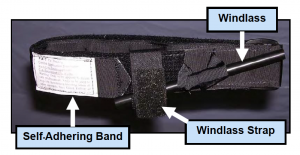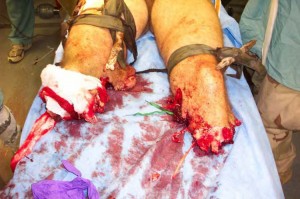a. Signs and Symptoms.
A sign is something the medic can detect, such as seeing a bruise, hearing noises during breathing, or measuring vital signs.
A symptom is a complaint voiced by the casualty that the medic cannot directly observe, such as pain in the casualty’s back or a headache.
b. Dressing.
The term dressing refers to the material that is placed directly on top of the open wound.
The dressing absorbs some of the blood and helps a clot to form. The clot, if successful, plugs the opening in the blood vessel and stops the bleeding. The dressing also protects the wound from additional contamination and injury. A dressing can be applied to any open wound.
c. Bandage.
A bandage is the material used to hold (secure) the dressing in place so the dressing will not slip and destroy the clot that is forming.
In addition to keeping the dressing in place, the pressure applied by the bandage also helps to compress the injured blood vessel and, thereby, reduce bleeding. The ends of the bandage are called the tails.
d. Field Dressing.
The field dressing (also called the field first aid dressing or bandage or the combat dressing) consists of a pad of sterile (germ-free) white dressing with a bandage (usually olive-drab) already attached to the dressing pad (figure 2-2).
The field dressing is wrapped in paper which is then sealed in a plastic envelope. The field dressing is starting to be replaced by the emergency trauma dressing discussed below.
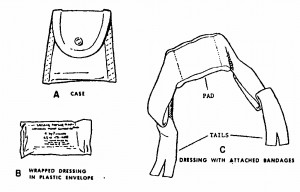
e. Emergency Trauma Dressing.
The emergency trauma dressing, sometimes called the “Israeli dressing,” is a combination dressing and compression bandage that incorporates a pressure applying locking bar and elastic bandage (figure 2-3).
This allows a great deal of pressure to be applied directly to the wound. The emergency trauma dressing has a thin, sterile non-adherent pad with a tan elastic bandage attached to the dressing. The emergency trauma dressing is part of the improved first aid kit (figure 2-4) that is replacing the first aid kit shown in figure 2-2.
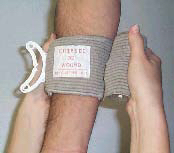
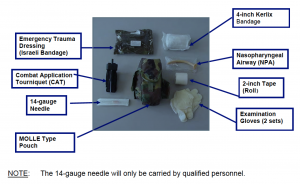
f. Pressure Dressing.
A pressure dressing consists of a wad of material placed over a regular dressing and secured with a tight bandage.
The pressure dressing is used to apply continuous pressure on the wound in an effort to compress blood vessels and help control bleeding. The pressure dressing does not stop the flow of blood through arteries and veins. A pressure dressing is only applied to a wound on a limb (arm or leg).
f. Pressure Point.
A pressure point is a place on the body where an artery lies near the skin surface and passes over a bony area.
Blood flow through the artery can be stopped by pressing on the artery at such a point. The artery, trapped between the bone and the pressure, collapses and blood cannot get through. Pressure points are not recommended on the battlefield when a tourniquet would be more appropriate since the tourniquet does not require the medic to dedicate his attention to applying pressure.
g. Tourniquet.
A tourniquet is a band placed around the upper arm, forearm, thigh, or lower leg that stops the flow of the blood below (distal to) the band.
A tourniquet is the treatment of choice during the care under fire phase of battle. During subsequent phases of care, the tourniquet will be assessed for removal (it may be kept in place if required).
(1) The limb below the level of the tourniquet may have to be amputated. However, tourniquets used in surgery to stop the blood flow to a limb are left in place for up to two hours without complications. If the casualty is allowed to continue bleeding, he will die. Therefore, the benefit of the tourniquet outweighs the potential risk to the casualty.
(2) Current research has proven that aggressive early use of tourniquets saves lives.
(3) It is the goal that every soldier has a tourniquet available and knows how to use it. Manufactured tourniquets such as the Combat Application Tourniquet (CAT) are great for meeting this goal. (See figure 2-5.) The combat medic should never forget that improvised tourniquets are still sound medical equipment and should be available to supplement manufactured tourniquets. (See figure 2-6.)
NOTE: Keep in mind the number of tourniquets that may be required at a moment’s notice. A HMMWV (high mobility multi-purpose wheeled vehicle) with a gunner can carry five personnel. That means that 20 tourniquets could be needed. Even with every soldier carrying a tourniquet, they may not be readily available to the combat medic under fire.
